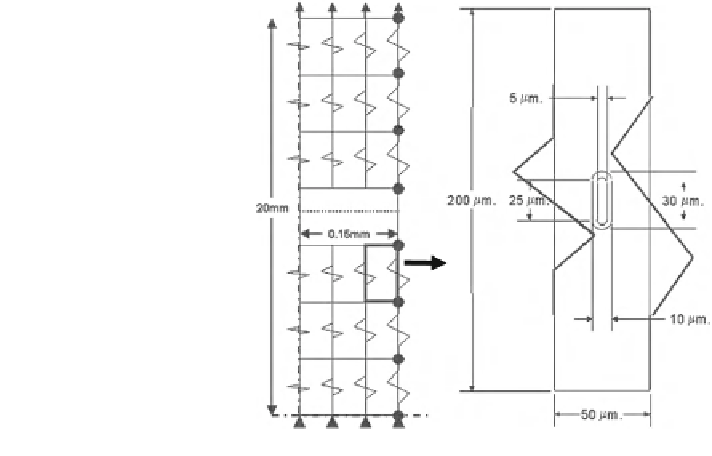Biomedical Engineering Reference
In-Depth Information
Fig. 12 Two level biphasic
simulation of a tendon
fascicle [
137
]. A biphasic
axisymmetric macroscale
model was created that
contained nonlinear springs
(Mesh, springs and model
dimensions shown on left).
The resulting strains and fluid
flux was applied to a
microscale model (right) that
contained nonlinear springs
and an ovoid shaped
fibroblast. Figure adapted
from [
137
]
Macro Model
Micro Model
combined with a microscopic biphasic FE model in order to examine the link
between macroscale loading and microscale mechanotransduction [
137
]. To
facilitate this, a macroscopic nonlinear biphasic model of a rat tail tendon fascicle
was first solved. The macroscopic model utilized nonlinear springs to represent the
transversely isotropic symmetry and nonlinear stress-strain behavior of tendon
fascicles (Fig.
12
, left). The springs were embedded in a porous matrix that had a
transversely isotropic porosity. The model was subjected to uniaxial loading under
a constant strain rate, and the computationally obtained macroscale stress-strain
curve was validated against experimental stress-strain data of rat tail tendon
fascicles. The deformation and fluid flux obtained from this model was then used
to generate boundary conditions for the microscale model, which featured an ovoid
shaped fibroblast aligned with the collagen matrix (Fig.
12
, right). Finally, the
predicted microscale fluid shear and microscale cell membrane deformation was
correlated to collagenase mRNA levels that were experimentally measured in rat
tail tendon fascicles. Briefly, fresh rat tail tendon fascicles were subjected to
loading scenarios identical to those applied to the simulations. Four loading sce-
narios were utilized, including low strain, high strain, low strain rate and high
strain rate. After each experiment, collagenase mRNA levels (MMP-13) were
measured using real time quantitative PCR.
The macroscale models predicted a stress-strain response that was in good
agreement with experimentally measured values. The microscale models predicted
significant cell membrane strains and fluid shear stress on the embedded cell for
the high strain rate and large strain models. The strains and shear stress correlated
to a decreased expression of mRNA for collagenase. Experimentally, it can be
concluded that decreased loading results in increased collagenase activity. By

Search WWH ::

Custom Search